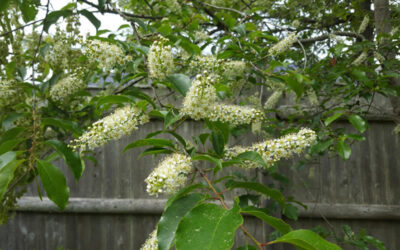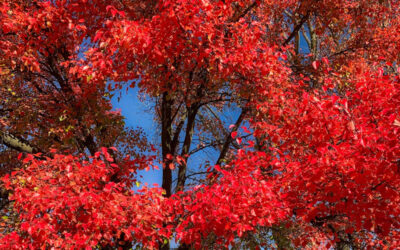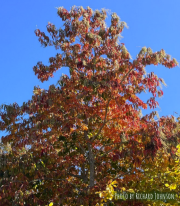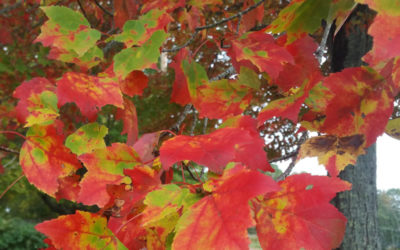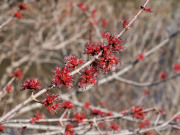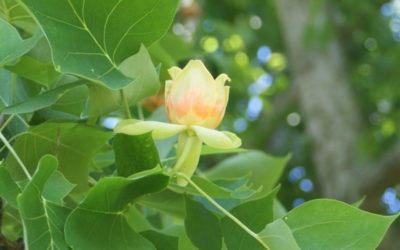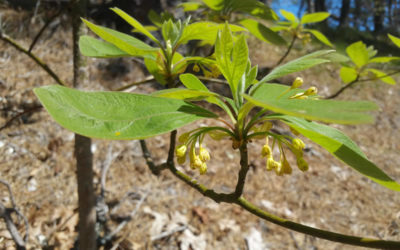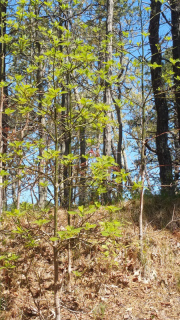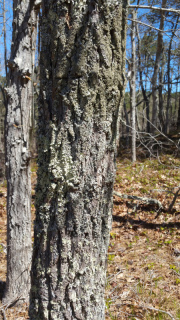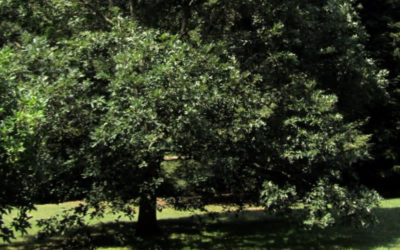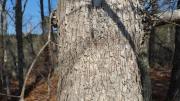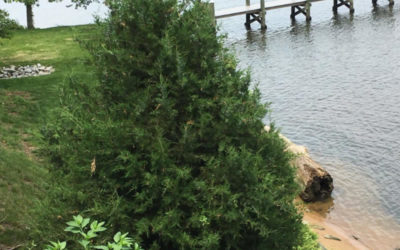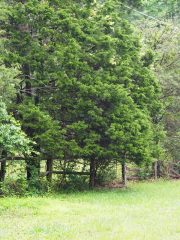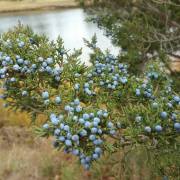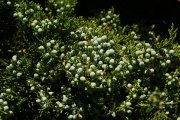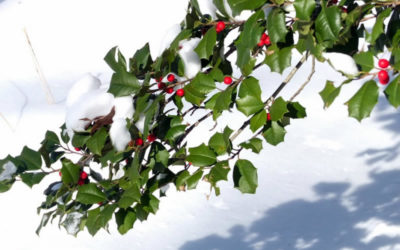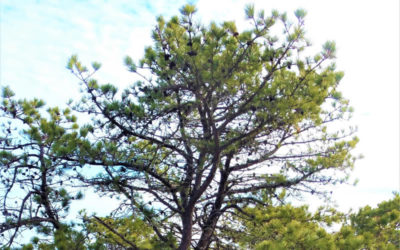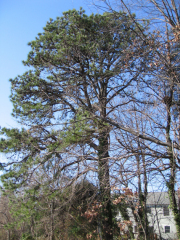Choose the Perfect Plant
This online tool is designed to help you find the native plants best-suited for specific sites that provide the greatest ecological function and benefit, and that will also complement your Cape Cod landscape design. Using the dropdowns below, you have the ability to find plants based on these six criteria: Plant Type, Sunlight, Soils, Bloom Month, Size, and Nature Benefits. Based on your choices, the results will automatically populate.
Virginia Bird-cherry / Chokecherry
Prunus virginiana
Growing Information
• Plant Type: Tree
• Sunlight: Full sun to partial shade.
• Soils: Dry-Moist. Prefers richer loams but is highly adaptable.
• Bloom Time: May-June. Fruits in late summer.
• Size: up to 30ft. Varies depending on light and soil conditions.
A large shrub or small deciduous tree with impressive adaptation to a wide variety of growing conditions. Can grow as a forest tree in moist shade or as a shrub on dry bluffs. Profuse cream- white flowers in late spring. Fruits are puckery sour but addictive and make a good July snack. Very attractive plant to birds and butterflies.
Garden Companions
Scrub Oak (Quercus ilicifolia); White Oak (Quercus alba); Pitch Pine (Pinus rigida); Sassafrass (Sassafras albidum); New Jersey Tea (Ceanothus americanus)
Nature Benefits
• Provides nectar for native bees and butterflies.
• Important food source for birds and mammals.
• Larval host to a huge variety of moths and butterflies such as hairstreaks and sphinx moths.
Natural Habitat
Moist woods, stream banks; prairie hillsides, fence rows, roadsides; sandy bluffs
Tupelo/Black Gum
Nyssa sylvatica
Growing Information
• Plant Type: Tree
• Sunlight: Full sun, part sun
• Soils: Medium to wet soils.
• Bloom Time: Small green flowers from April-May, producing a sour black fruit in fall.
• Size: 20-50 feet in height.
Spectacular fall colors and pyramidal shape. Extremely high wildlife value, as the fruits are enjoyed by birds and small mammals and the flowers are important for early spring pollinators. The fruit is edible but quite sour. This tree is a favorite of European honeybees for nesting and honey production. Slow grower and can live over 600 years.
Garden Companions
Red Maple (Acer Rubrum); Great Rhododendron (Rhododendron maximum); Mountain Laurel (Kalmia latifolia); Canada Mayflower (Maianthemium canadense); Southern Magnolia (Magnolia Grandiflora); Native ferns
Nature Benefits
• Provides nectar for native bees.
• Attracts birds and small mammals with fruit in the fall.
• Hollows in the tree are very popular nesting sites for woodpeckers, owls, small mammals, and honeybees.
Natural Habitat
Moist deciduous forests and swamps. Occasionally tolerant of drier sites.
Sourwood
Oxydendrum arboreum
Growing Information
• Plant Type: Tree
• Sunlight: Sun, part shade
• Soils: Acidic, well-drained
• Bloom Time: July, August
• Size: 15 – 30 feet in height; 12 foot spread
This deciduous tree, while native to southwest Pennsylvania and states south, sourwood makes a good ornamental landscape tree on Cape Cod. It is in the heath family and its fragrant summer flowers are pollinated by insects and are a good source of nectar. Fall color is outstanding! Trees planted in the shade may grow taller and flower less. Salt tolerant and can withstand periodic droughts if established.
Garden Companions
Black Huckleberry (Gaylussacia baccata), Bayberry (Morella pensylvanica), Mountain Laurel (Kalmia latifolia)
Nature Benefits
• Attracts pollinators and butterflies
• Attracts songbirds
• Host plant of sphinx moths
Native Habitat
In its native range, found as single trees at forest edges, often within upland oak forests.
PHOTOS
Red Maple
Acer rubrum
Growing Information
• Plant Type: Tree
• Sunlight: Sun
• Soils: Moist to average to dry
• Bloom Time: April
• Size: Tall
Considered a keystone species because of its value to a diverse number of insect and animal species. Red maple is known for its beautiful fall color. It can tolerate a wide range of soils, variable pH and even pollution, and therefore should be considered for use as a street tree, parks, and in rain gardens.
Garden Companions
Black chokeberry (Aronia melanocarpa); American Hazelnut (Corylus americana); Anise-scented Goldenrod (Solidago odoro); New England aster (Symphyotrichum novae-angliae); Beardtongue (Penstemon digitalis)
Nature Benefits
• Host for over 275 species of moth and butterfly caterpillars.
• Spring flowers offer nectar and pollen for a variety of insects.
• Seeds provide food for both birds and mammals.
Native Habitat
Occurs in lowlands and wetlands but can also be found in hardwood forests.
Photos
Tulip Tree
Liriodendron tulipifera
Growing Information
• Plant Type: Tree
• Sunlight: Sun
• Soils: Average moisture
• Bloom Time: June
• Size: Tall
Considered a shade tree, the tulip tree is one of the tallest hardwoods in North America. It gets its name from the shape of its flower and the shape of the leaf looks like the outline of a tulip. If out in the open, the shape of the tree is pyramidal. This tree is fast growing and can live 175 years.
Garden Companions
Black chokeberry (Aronia melanocarpa); American Hazelnut (Corylus americana); Anise-scented Goldenrod (Solidago odoro); Mountain Mint (Pycnanthemum muticum); Beardtongue (Penstemon digitalis)
Nature Benefits
• Host for 20 species of moth and butterfly caterpillars, including the tulip tree silk moth.
• Ruby-throated hummingbirds and bees seek out the flowers for early season forage.
• Seeds mature in summer and persist into winter, providing food for both birds and mammals, including finches, cardinals, quail, and small mammals.
Native Habitat
Occurs in lowlands and gentle sloping hillsides.
Photos
Sassafras
Sassafras albidum
Growing Information
• Plant Type: Tree
• Sunlight: Sun, part shade
• Soils: Average, dry to wet
• Bloom Time: Yellow in April, May
• Size: 6-15 feet in height; 6-15 foot spread
Plant or save Sassafras for texture and to attract wildlife. It has a sweet, fruity aroma and provides vibrant fall color ranging from red to orange to yellow. It can sucker into a small grove but is easily controlled. It is dioecious meaning the plant either has male or female flowers and only the female plant produces fruit. Until 1960 when banned for containing carcinogenic safrole, the roots and root bark provided sassafras tea and were used to flavor root beer.
Garden Companions
Witch Hazel (Hamamelis virginiana), Mapleleaf Viburnum (Viburnum acerifolium), Lowbush Blueberry (Vaccinium angustifolium), Pennsylvania Sedge (Carex pensylvanica), Wavy Hairgrass (Deschampsia flexuosa), Teaberry (Gaultheria procumbens)
Nature Benefits
• Larval host for butterflies and moths including Spicebush Swallowtail and Promethea Silk Moth.
• Birds feed on the fruit.
• Attracts a variety of pollinators.
Native Habitat
Occurs in forests, forest edges, roadsides.
Photos
White Pine
Pinus strobus
Growing Information
• Plant Type: Tree
• Sunlight: Sun, part shade
• Soils: Average, dry
• Bloom Time: Insignificant
• Size: 60-90 feet in height; 25-40 foot spread
Commonly found, White Pines grow reasonably rapidly, are tall, and have soft evergreen needles in bunches of 5, making it a good shade tree. Seedlings are more shade-tolerant than most pines and trees are long-lived, up to 450 years.
Garden Companions
Arrowwood (Viburnum dentatum), Blueberries (Vaccinium spp.), Black Huckleberry (Gaylussacia baccata), Teaberry (Gaultheria procumbens), Sweetfern (Comptonia peregrina), Bracken Fern (Pteridium aquilinum)
Nature Benefits
• Provides nesting habitat for Bald Eagles, cavity-nesting and other birds
• Songbirds and small mammals eat the seeds
• Caterpillar host for the Eastern Pine Elfin and Pine-devil Moth
Native Habitat
Occurs in forests, forest edges, swamps, woodlands
White Oak
Quercus alba
Growing Information
• Plant Type: Tree
• Sunlight: Sun, part shade
• Soils: Dry, average
• Bloom Time: April, May – pollen is windblown
• Size: 60-80 feet in height; 30-40 foot spread
Plant the majestic, long-lived White Oak for shade and stately structure as a backbone in the garden. It prefers full sun. Fall color of purple to wine-red. Oaks are a keystone species in the Cape’s ecosystem because they support more wildlife than any other plant found in our landscape.
Garden Companions
Flowering Dogwood (Cornus florida), Arrowwood Viburnum (Viburnum dentatum), Rosebay Rhododenron (Rhododendron maximum)
Nature Benefits
• Supports the caterpillars of over 535 species of butterflies and moths.
• Acorns are food source for birds, deer, squirrels, and other rodents.
Native Habitat
Occurs in woods, dry upland slopes, well-drained loam in bottomlands.
Photos
Eastern Red Cedar
Juniperus virginiana
Growing Information
• Plant Type: Tree
• Sunlight: Sun, part shade
• Soils: Dry, average
• Bloom Time: Non Flowering
• Size: 15-30 feet in height; 3-10 foot spread
Long-lived Eastern Red Cedar can be used for screening with its conical or columnar dense habit. It has peeling red bark, fragrant foliage, and blue fruit on the female plants. Tolerates drought, salt spray, deer, erosion, heat, and cold.
Garden Companions
Inkberry (Ilex glabra), Little Bluestem (Schizachyrium scoparium), White Oak (Quercus alba)
Nature Benefits
• Berries eaten by mammals and many songbirds such as Cedar Waxwing and Bluebirds.
• Favorite nesting site for some birds.
• Dense protective shelter valuable for birds in winter.
Native Habitat
Occurs in woodland edges, meadows, pastures, coastal lowlands.
Photos
American Holly
Ilex opaca
Growing Information
• Plant Type: Tree
• Sunlight: Sun, part shade
• Soils: Moist, well-drained, average
• Bloom Time: White flowers in April, May, June
• Size: 12-30 feet in height; 8-14 foot spread
Plant American Holly as an evergreen specimen, massed, or for hedges. Red berries persist through the winter but are only found on female plants when there is a male plant nearby.
Garden Companions
Flowering Dogwood (Cornus florida), Mapleleaf Viburnum (Viburnum acerifolium)
Nature Benefits
• Berries eaten by many songbirds, gamebirds, and mammals
• Larval host for Henry’s Elfin butterfly
Native Habitat
Occurs in shaded woods, stream and riverbanks, uplands, and lowlands.
Photos
Pitch Pine
Pinus rigida
Growing Information
• Plant Type: Tree
• Sunlight: Sun
• Soils: Dry, average
• Bloom Time: May, June
• Size: 30-60 feet in height; 15-25 foot spread
The hardy Pitch Pine is suitable for planting in dry soil that other plants don’t tolerate. It grows rapidly once established in bare, sandy, poor soil. It is resistant to fire, deer, salt, and injury. It sends out shoots from the trunk in response to stress.
Garden Companions
Bayberry (Morella caroliniensis), Black Huckleberry (Gaylussacia baccata), Scrub Oak (Quercus ilicifolia), White Oak (Quercus alba)
Nature Benefits
• Larval host for Pine-devil moth.
• Seeds feed squirrels, birds, and other wildlife.
Native Habitat
Occurs in sandy barrens, coastal plains, and part of the pitch pine-oak plant community.

